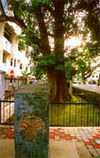Background of Kuala Kangsar
1.
Bus Stand
2. Clifford School
3. Clock Tower

4.
First Rubber Tree
5.
Golf Course
6. Handicraft Center
7. Hentian Sayong Chalet
8. Hospital
9. Hulu Kenas
10. Iskandar Bridge

11. Iskandariah Palace
12. Istana Hulu
|
|
13.
Keris Monument
14. Ladies Hospital
15. The Malay College

16.
Ubudiah Mosque
17. Merdeka Hall
18. Pavillion Square Tower
19. Railway Station
20. King's Pavillion (now SMPRPK)
21. Ridzuaniah Mosque
22. Royal Mousoment

23. Royal Museum
24. Traditional Handicraft Center
25. Traditional 'Pantai Besi' Center
26. Victoria Bridge |
50 kilometers from Ipoh is Kuala Kangsar. While the former is the
capital of Perak, Kuala Kangsar is the state's royal town. Compared
to Ipoh, life in Kuala Kangsar is much more relaxed and slower-paced.
It is a town littered with beautiful historical attractions, with
beautiful green mountains and the massive Perak river as a backdrop.
Ambrose B. Rathborne in his Camping and Tramping in Malaya
(1883) wrote that it had "one of the prettiest view in the Straits...
overlooking Sungai Perak, up whose beautiful valley an uninterrupted
view is obtained."
Before the discovery of tin in the Kinta Valley, Kuala Kangsar was
Perak's major town. The Sultan of Perak had already made Kuala Kangsar
his residence for quite sometime. The old Istana Kuning has now been
converted into the Royal Museum while the Sultan himself keeps his
official residence at Iskandariah Palace. Not far from Iskandariah
Palace is Ubudiah mosque, an edifice regarded by many as the most
beautiful of its kind in the country. On the way to Bukit Candan where
both are situated, you can see a majestic colonial building perched
on the hillside. This is the King's Pavillion, once the Residency
and much later part of MCKK. It housed the youngest batch. Now it
houses SM Raja Perempuan Kalsom, formerly known as the Government
English Girls School.
The Perak riverside, better known as the Lembah is laced with parks,
small handicraft shops, eating stalls and walkways. In the olden days,
the Collegians had an affectionate name for the place - 'New York'
and frequented the stalls there every weekend.
The main road of the town itself is littered with old Chinese shops,
although new shops are slowly making way. The famous Yut Loy restaurant-serving
its famous paus is located along the main road. At the end of the
road is a roundabout that brings you either to the golf course, the
solitary cinema (Lido) or to Clifford School, MCKK's favourite arch-nemesis.
Clifford is in fact older than MCKK, having been established in the
late 1890's. The school is situated opposite MCKK. Rubber,
a commodity once synonomous to Malaya was first planted in Kuala Kangsar,
and the country's first rubber tree is maintained a few hundred meters
away from the College. On the other side of the road which passes
in front of the College is the train station. The train is the traditional
way for many Collegians of the past, and to this day the students
still do enjoy the train ride every now and then despite the advent
of the North-South Highway. It posseses an old world charm to it,
making each ride an experience to remember.

